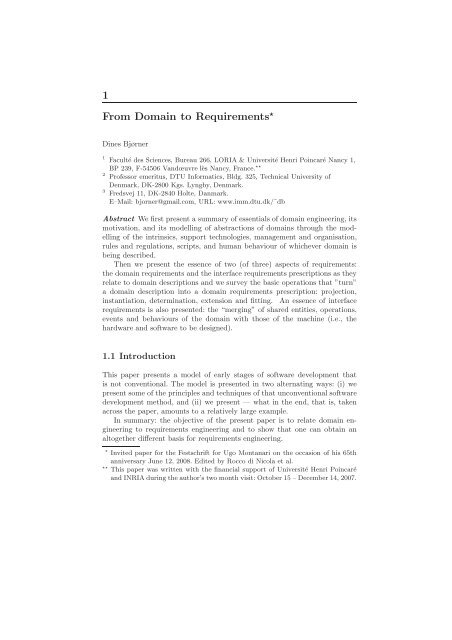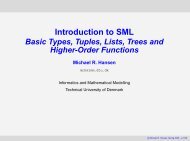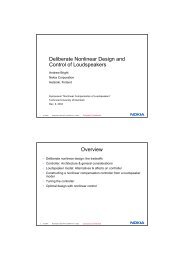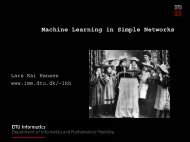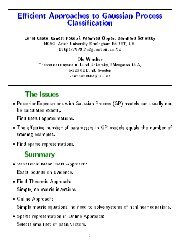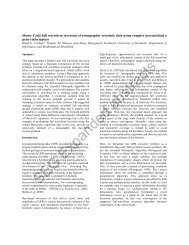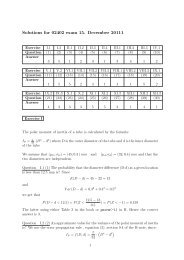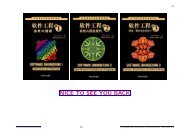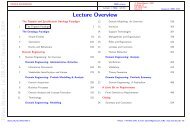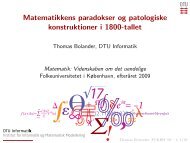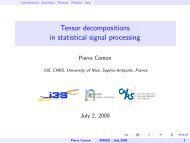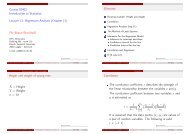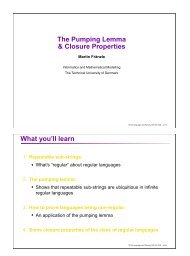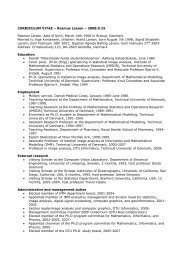the Ugo Montanari Festschrift paper - DTU Informatics
the Ugo Montanari Festschrift paper - DTU Informatics
the Ugo Montanari Festschrift paper - DTU Informatics
You also want an ePaper? Increase the reach of your titles
YUMPU automatically turns print PDFs into web optimized ePapers that Google loves.
1<br />
From Domain to Requirements ⋆<br />
Dines Bjørner<br />
1 Faculté des Sciences, Bureau 266, LORIA & Université Henri Poincaré Nancy 1,<br />
BP 239, F-54506 Vandœuvre lès Nancy, France. ⋆⋆<br />
2 Professor emeritus, <strong>DTU</strong> <strong>Informatics</strong>, Bldg. 325, Technical University of<br />
Denmark, DK-2800 Kgs. Lyngby, Denmark.<br />
3 Fredsvej 11, DK-2840 Holte, Danmark.<br />
E–Mail: bjorner@gmail.com, URL: www.imm.dtu.dk/˜db<br />
Abstract We first present a summary of essentials of domain engineering, its<br />
motivation, and its modelling of abstractions of domains through <strong>the</strong> modelling<br />
of <strong>the</strong> intrinsics, support technologies, management and organisation,<br />
rules and regulations, scripts, and human behaviour of whichever domain is<br />
being described.<br />
Then we present <strong>the</strong> essence of two (of three) aspects of requirements:<br />
<strong>the</strong> domain requirements and <strong>the</strong> interface requirements prescriptions as <strong>the</strong>y<br />
relate to domain descriptions and we survey <strong>the</strong> basic operations that ”turn”<br />
a domain description into a domain requirements prescription: projection,<br />
instantiation, determination, extension and fitting. An essence of interface<br />
requirements is also presented: <strong>the</strong> “merging” of shared entities, operations,<br />
events and behaviours of <strong>the</strong> domain with those of <strong>the</strong> machine (i.e., <strong>the</strong><br />
hardware and software to be designed).<br />
1.1 Introduction<br />
This <strong>paper</strong> presents a model of early stages of software development that<br />
is not conventional. The model is presented in two alternating ways: (i) we<br />
present some of <strong>the</strong> principles and techniques of that unconventional software<br />
development method, and (ii) we present — what in <strong>the</strong> end, that is, taken<br />
across <strong>the</strong> <strong>paper</strong>, amounts to a relatively large example.<br />
In summary: <strong>the</strong> objective of <strong>the</strong> present <strong>paper</strong> is to relate domain engineering<br />
to requirements engineering and to show that one can obtain an<br />
altoge<strong>the</strong>r different basis for requirements engineering.<br />
⋆ Invited <strong>paper</strong> for <strong>the</strong> <strong>Festschrift</strong> for <strong>Ugo</strong> <strong>Montanari</strong> on <strong>the</strong> occasion of his 65th<br />
anniversary June 12, 2008. Edited by Rocco di Nicola et al.<br />
⋆⋆ This <strong>paper</strong> was written with <strong>the</strong> financial support of Université Henri Poincaré<br />
and INRIA during <strong>the</strong> author’s two month visit: October 15 – December 14, 2007.
2 Dines Bjørner<br />
1.2 The Triptych Principle of Software Engineering<br />
We start, unconventionally, by enunciating a principle. The principle expresses<br />
how we see software development as centrally consisting of three<br />
“programming-like” phases based on <strong>the</strong> following observation: before software<br />
can be designed we must understand its requirements, and before requirements<br />
can be prescribed we must understand <strong>the</strong> application domain.<br />
We <strong>the</strong>refore see software development proceeding, ideally, in three phases: a<br />
first phase of domain engineering, a second phase of requirements engineering,<br />
and a third phase of software design.<br />
The first paragraphs of Sects. 1.3 and 1.4 explain what <strong>the</strong> objectives of<br />
domain engineering and requirements engineering are. The sections o<strong>the</strong>rwise<br />
outline major development stages and steps of <strong>the</strong>se two phases.<br />
1.3 Domain Engineering<br />
The objective of domain engineering is to create a domain description. A<br />
domain description specifies entities, functions, events and behaviours of <strong>the</strong><br />
domain such as <strong>the</strong> domain stakeholders think <strong>the</strong>y are. A domain description<br />
thus (indicatively) expresses what <strong>the</strong>re is. A domain description expresses no<br />
requirements let alone anything about <strong>the</strong> possibly desired (required) software.<br />
1.3.1 Stages of Domain Engineering<br />
To develop a proper domain description necessitates a number of development<br />
stages: (i) identification of stakeholders, (ii) domain knowledge acquisition,<br />
(iii) business process rough-sketching, (iv) domain analysis, (v) domain modelling:<br />
developing abstractions and verifying properties, (vi) domain validation<br />
and (vii) domain <strong>the</strong>ory building.<br />
Business process (BP) rough-sketching amount to rough, narrative outlines<br />
of <strong>the</strong> set of business processes as experienced by each of <strong>the</strong> stakeholder<br />
groups. BP engineering is in contrast to BR re-engineering (BPR) which we<br />
shall cover later, but briefly in Sect. 1.4.2.<br />
We shall only cover domain modelling.<br />
1.3.2 First Example of a Domain Description<br />
We exemplify a transportation domain. By transportation we shall mean <strong>the</strong><br />
movement of vehicles from hubs to hubs along <strong>the</strong> links of a net.
Rough Sketching — Business Processes<br />
1 From Domain to Requirements 3<br />
The basic entities of <strong>the</strong> transportation “business” are <strong>the</strong> (i) nets with <strong>the</strong>ir<br />
(ii) hubs and (iii) links, <strong>the</strong> (iv) vehicles, and <strong>the</strong> (v) traffic (of vehicles on <strong>the</strong><br />
net). The basic functions are those of (vi) vehicles entering and leaving <strong>the</strong><br />
net (here simplified to entering and leaving at hubs), (vii) for vehicles to make<br />
movement transitions along <strong>the</strong> net, and (viii) for inserting and removing links<br />
(and associated hubs) into and from <strong>the</strong> net. The basic events are those of<br />
(ix) <strong>the</strong> appearance and disappearance of vehicles, and (x) <strong>the</strong> breakdown<br />
of links. And, finally, <strong>the</strong> basic behaviours of <strong>the</strong> transportation business are<br />
those of (xi) vehicle journey through <strong>the</strong> net and (xii) net development &<br />
maintenance including insertion into and removal from <strong>the</strong> net of links (and<br />
hubs).<br />
Narrative — Entities<br />
By an entity we mean something we can point to, i.e., something manifest, or<br />
a concept abstracted from, such a phenomenon or concept <strong>the</strong>reof.<br />
Among <strong>the</strong> many entities of transportation we start with nets, hubs, and links.<br />
A transportation net consists of hubs and links. Hubs and links are different<br />
kinds of entities. Conceptually hubs (links) can be uniquely identified. From<br />
a link one can observe <strong>the</strong> identities of <strong>the</strong> two distinct hubs it links. From a<br />
hub one can observe <strong>the</strong> identities of <strong>the</strong> one or more distinct links it connects.<br />
O<strong>the</strong>r entities such as vehicles and traffic could as well be described. Please<br />
think of <strong>the</strong>se descriptions of entities as descriptions of <strong>the</strong> real phenomena<br />
and (at least postulated) concepts of an actual domain.<br />
Formalisation — Entities<br />
type H, HI, L, LI, N = H-set × L-set<br />
value obs HI: H→HI, obs LI: L→LI, obs HIs: L→HI-set,obs LIs: H→LI-set<br />
axiom<br />
∀ (hs,ls):N •<br />
card hs≥2 ∧ card ls≥1 ∧ ∀ h:H • h ∈ hs ⇒<br />
∀ li:LI • li ∈ obs LIs(h) ⇒<br />
∃ l ′ :L • l ′ ∈ ls∧li=obs LI()∧obs HI(h) ∈ obs HIs(l ′ )∧<br />
∀ l:L • l ∈ ls ⇒<br />
∃ h ′ ,h ′′ :H • {h ′ ,h ′′ }⊆hs∧obs HIs(l)={obs HI(h ′ ),obs HI(h ′′ )}<br />
value xtr HIs: N → HI-set,xtr LIs: N → LI-set
4 Dines Bjørner<br />
Narrative — Operations<br />
By an operation (of a domain) we mean a function that applies to entities of<br />
<strong>the</strong> domain and yield entities of that domain — whe<strong>the</strong>r <strong>the</strong>se entities are<br />
actual phenomena or concepts of <strong>the</strong>se or of o<strong>the</strong>r phenomena.<br />
Actions (by domain stakeholders) amount to <strong>the</strong> execution of operations.<br />
Among <strong>the</strong> many operations performed in connection with transportation<br />
we illustrate some on nets. To a net one can join new links in ei<strong>the</strong>r of three<br />
ways: The new link connects two new hubs — so <strong>the</strong>se must also be joined ,<br />
or The new link connects a new hub with an existing hub — so it must also<br />
be joined, or The new link connects two existing hubs. In any case we must<br />
ei<strong>the</strong>r provide <strong>the</strong> new hubs or identify <strong>the</strong> existing hubs.<br />
From a net one can remove a link. Three possibilities now exists: The<br />
removed link would leave its two connected hubs isolated unless <strong>the</strong>y are also<br />
removed — so <strong>the</strong>y are; The removed link would leave one of its connected<br />
hubs isolated unless it is also removed — so it is; or The removed link connects<br />
two hubs into both of which o<strong>the</strong>r links are connected — so all is OK. (Note<br />
our concern for net invariance.) Please think of <strong>the</strong>se descriptions of operations<br />
as descriptions of <strong>the</strong> real phenomena and (at least postulated) concepts of an<br />
actual domain. (Thus <strong>the</strong>y are not prescriptions of requirements to software<br />
let alone specifications of software operations.)<br />
Formalisation — Operations<br />
type<br />
NetOp = InsLnk | RemLnk<br />
InsLnk == 2Hs(h1:H,l:L,h2:H)|1H(hi:HI,l:L,h:H)|0H(hi1:HI,l:L,hi2:HI)<br />
RemLnk == RmvL(li:LI)<br />
value<br />
int NetOp: NetOp → N ∼ → N<br />
pre int NetOp(op)(hs,ls) ≡<br />
case op of<br />
2Hs(h1,l,h2) →<br />
{h1,h2}∩ hs={}∧l∉ ls∧<br />
obs HIs(l)={obs HI(h1),obs HI(h2)}∧<br />
{obs HI(h1),obs HI(h2)}∩ xtr HIs(hs)={}∧<br />
obs LIs(h1)={li}∧obs LIs(h2)={li},<br />
1H(hi,l,h) → ...,<br />
0H(hi1,l,hi2) → ...<br />
end<br />
int NetOp(op)(hs,ls) ≡<br />
case op of
1 From Domain to Requirements 5<br />
2Hs(h1,l,h2) →<br />
(hs ∪ {h1,h2},ls ∪ {l}),<br />
1H(hi,l,h) →<br />
(hs\{xtr H(hi,hs)}∪{h,aLI(xtr H(hi,hs),obs LI(l))},ls ∪ {l}),<br />
0H(hi1,l,hi2) → ...,<br />
RmvL(li) → ...<br />
end<br />
xtr H: HI × H-set ∼ → H<br />
xtr H(hi,hs) ≡ let h:H • h ∈ hs ∧ obs HI(h)=hi in h end<br />
pre ∃ h:H • h ∈ hs ∧ obs HI(h)=hi<br />
aLI: H × LI → H, sLI: H × LI → H<br />
aLI(h,li) as h ′ ,<br />
pre li ∉ obs LIs(h), post obs LIs(h ′ )={li} ∪ obs LIs(h)∧ ...<br />
sLI(h ′ ,li) as h,<br />
pre li ∈ obs LIs(h ′ ), post obs LIs(h)=obs LIs(h ′ )\{li}∧ ...<br />
The ellipses, . . . , shall indicate that previous properties of h holds for h ′ .<br />
Narrative — Events<br />
By an event of a domain we shall here mean an instantaneous change of domain<br />
state (here, for example, “<strong>the</strong>” net state) not directly brought about by some<br />
willed action of <strong>the</strong> domain but ei<strong>the</strong>r by “external” forces or implicitly, as<br />
an unintended result of a willed action.<br />
Among <strong>the</strong> “zillions” of events that may occur in transportation we single out<br />
just one. A link of a net ceases to exist as a link. 4<br />
In order to model transportation events we — ad hoc — introduce a transportation<br />
state notion of a net paired with some — ad hoc — “conglomerate”<br />
of remaining state concepts referred to as ω : Ω.<br />
Formalisation — Events<br />
type<br />
Link Disruption == LiDi(li:LI)<br />
channel<br />
x:(Link Disruption|...)<br />
value<br />
transportation transition: (N × Ω) → in x (N × Ω)<br />
transportation transition(n,ω) ≡<br />
... ⌈⌉ let xv = x? in
6 Dines Bjørner<br />
case xv of<br />
LiDi(li) → (int NetOp(RmvL(li))(hs,ls),line dis(ω))<br />
... end end ⌈⌉ ...<br />
line dis: Ω → Ω<br />
Narrative — Behaviours<br />
By a behaviour we mean a possibly infinite sequence of zero, one or more<br />
actions and events.<br />
We illustrate just one of very many possible transportation behaviours.<br />
A net behaviour is a sequence of zero, one or more executed net operations:<br />
<strong>the</strong> openings (insertions) of new links (and implied hubs) and <strong>the</strong> closing<br />
(removals) of existing links (and implied hubs), and occurrences of external<br />
events (limited here to link disruptions).<br />
Formalisation — Behaviours<br />
channel<br />
x:...<br />
value<br />
transportation transition: (N × Ω) → in x (N × Ω)<br />
transportation transition(n,ω) ≡<br />
... ⌈⌉ let xv = x? in case xv of ... end end<br />
... ⌈⌉ let op:NetOp • pre IntNetOp(op)(n) in IntNetOp(op)(n) end ...<br />
transportation: (N × Ω) → in x Unit<br />
transportation(n,ω) ≡<br />
let (n ′ ,ω ′ ) = transportation transition(n,ω) in<br />
transportation (n ′ ,ω ′ ) end<br />
1.3.3 Domain Modelling: Describing Facets<br />
Domain modelling, as we shall see, entails modelling a number of domain<br />
facets.<br />
By a domain facet we mean one amongst a finite set of generic ways of<br />
analysing a domain: a view of <strong>the</strong> domain, such that <strong>the</strong> different facets cover<br />
conceptually different views, and such that <strong>the</strong>se views toge<strong>the</strong>r cover <strong>the</strong><br />
domain.<br />
These are <strong>the</strong> facets that we find “span” a domain in a pragmatically<br />
sound way: intrinsics, support technology, management & organisation, rules<br />
& regulations, scripts and human behaviour: We shall now survey <strong>the</strong>se facets.
1 From Domain to Requirements 7<br />
Domain Intrinsics<br />
By domain intrinsics we mean those phenomena and concepts of a domain<br />
which are basic to any of <strong>the</strong> o<strong>the</strong>r facets (listed earlier and treated, in some<br />
detail, below), with such domain intrinsics initially covering at least one specific,<br />
hence named, stakeholder view.<br />
For <strong>the</strong> large example of Sect. 1.3.2, we claim that <strong>the</strong> net, hubs and links were<br />
intrinsic phenomena of <strong>the</strong> transportation domain; and that <strong>the</strong> operations of<br />
joining and removing links were not: one can explain transportation without<br />
<strong>the</strong>se operations. We will now augment <strong>the</strong> domain description of Sect. 1.3.2<br />
with an intrinsic concept, namely that of <strong>the</strong> states of hubs and links: where<br />
<strong>the</strong>se states indicate desirable directions of flow of movement.<br />
A Transportation Intrinsics — Narrative.<br />
With a hub we can associate a concept of hub state. The pragmatics of a hub<br />
state is that it indicates desirable directions of flow of vehicle movement from<br />
(incoming) links to (outgoing) links. The syntax of indicating a hub state is<br />
(<strong>the</strong>refore) that of a possibly empty set of triples of two link identifiers and<br />
one hub identifier where <strong>the</strong> link identifiers are those observable from <strong>the</strong><br />
identified hub.<br />
With a link we can associate a concept of link state. The pragmatics of a<br />
link state is that it indicates desirable directions of flow of vehicle movement<br />
from (incoming, identified) hubs to (outgoing, identified) hubs along an identified<br />
link. The syntax of indicating a link state is (<strong>the</strong>refore) that of a possibly<br />
empty set of triples of pairs of identifiers of link connected hub and a link<br />
identifier where <strong>the</strong> hub identifiers are those observable from <strong>the</strong> identified<br />
link.<br />
A Transportation Intrinsics — Formalisation.<br />
type<br />
X = LI×HI×LI [ crossings of a hub ], P = HI×LI×HI [ paths of a link ]<br />
HΣ = X-set [ hub states ], LΣ = P-set [ link states ]<br />
value<br />
obs HΣ: H → HΣ, obs LΣ: L → LΣ,<br />
xtr Xs: H → X-set, xtr Ps: L → P-set<br />
xtr Xs(h) ≡<br />
{(li,hi,li ′ )|li,li ′ :LI,hi:HI • {li,li ′ }⊆obs LIs(h)∧hi=obs HI(h)}<br />
xtr Ps(l) ≡<br />
{(hi,li,hi ′ )|hi,hi ′ :HI,li:LI • {hi,hi ′ }=obs HIs(l)∧li=obs LI(l)}<br />
axiom ∀ n:N,h:H;l:L • h ∈ obs Hs(n)∧l ∈ obs Ls(n) ⇒<br />
obs HΣ(h)⊆xtr Xs(h) ∧ obs LΣ(l)⊆xtr Ps(l)
8 Dines Bjørner<br />
Domain Support Technologies<br />
By domain support technologies we mean ways and means of implementing<br />
certain observed phenomena or certain conceived concepts.<br />
A Transportation Support Technology Facet — Narrative, 1.<br />
Earlier we claimed that <strong>the</strong> concept of hub and link states was an intrinsics<br />
facet of transport nets. But we did not describe how hubs or links might change<br />
state, yet hub and link state changes should also be considered intrinsic facets.<br />
We <strong>the</strong>re introduce <strong>the</strong> notions of hub and link state spaces and hub and link<br />
state changing operations. A hub (link) state space is <strong>the</strong> set of all states<br />
that <strong>the</strong> hub (link) may be in. A hub (link) state changing operation can be<br />
designated by <strong>the</strong> hub and a possibly new hub state (<strong>the</strong> link and a possibly<br />
new link state).<br />
A Transportation Support Technology Facet — Formalisation, 1.<br />
type HΩ = HΣ-set, LΩ = LΣ-set<br />
value obs HΩ: H → HΩ, obs LΩ: L → LΩ<br />
axiom ∀ h:H • obs HΣ(h) ∈ obs HΩ(h) ∧ ∀ l:L • obs LΣ(l) ∈ obs LΩ(l)<br />
value<br />
chg HΣ: H × HΣ → H, chg LΣ: L × LΣ → L<br />
chg HΣ(h,hσ) as h ′ , pre hσ ∈ obs HΩ(h), post obs HΣ(h ′ )=hσ<br />
chg LΣ(l,lσ) as l ′ , pre lσ ∈ obs LΩ(h), post obs HΣ(l ′ )=lσ<br />
A Transportation Support Technology Facet — Narrative, 2.<br />
Well, so far we have indicated that <strong>the</strong>re is an operation that can change<br />
hub and link states. But one may debate whe<strong>the</strong>r those operations shown are<br />
really examples of a support technology. (That is, one could equally well claim<br />
that <strong>the</strong>y remain examples of intrinsic facets.) We may accept that and <strong>the</strong>n<br />
ask <strong>the</strong> question: How to effect <strong>the</strong> described state changing functions ? In<br />
a simple street crossing a semaphore does not instantaneously change from<br />
red to green in one direction while changing from green to red in <strong>the</strong> cross<br />
direction. Ra<strong>the</strong>r <strong>the</strong>re is are intermediate sequences of green/yellow/red and<br />
red/yellow/green states to help avoid vehicle crashes and to prepare vehicle<br />
drivers. Our “solution” is to modify <strong>the</strong> hub state notion.<br />
A Transportation Support Technology Facet — Formalisation, 2.<br />
type<br />
Colour == red | yellow | green<br />
X = LI×HI×LI×Colour [ crossings of a hub ]<br />
HΣ = X-set [ hub states ]
1 From Domain to Requirements 9<br />
value<br />
obs HΣ: H → HΣ, xtr Xs: H → X-set<br />
xtr Xs(h) ≡<br />
{(li,hi,li ′ ,c)|li,li ′ :LI,hi:HI,c:Colour • {li,li ′ }⊆obs LIs(h)∧hi=obs HI(h)}<br />
axiom<br />
∀ n:N,h:H • h ∈ obs Hs(n) ⇒ obs HΣ(h)⊆xtr Xs(h) ∧<br />
∀ (li1,hi2,li3,c),(li4,hi5,li6,c ′ ):X •<br />
{(li1,hi2,li3,c),(li4,hi5,li6,c ′ )}⊆obs HΣ(h) ∧<br />
li1=li4 ∧ hi2=hi5 ∧ li3=li6 ⇒ c=c ′<br />
A Transportation Support Technology Facet — Narrative, 3.<br />
We consider <strong>the</strong> colouring, or any such scheme, an aspect of a support technology<br />
facet. There remains, however, a description of how <strong>the</strong> technology<br />
that supports <strong>the</strong> intermediate sequences of colour changing hub states.<br />
We can think of each hub being provided with a mapping from pairs of<br />
“stable” (that is non-yellow coloured) hub states (hσ i ,hσ f ) to well-ordered sequences<br />
of intermediate “un-stable’ (that is yellow coloured) hub states paired<br />
with some time interval information 〈(hσ ′ , tδ ′ ), (hσ ′′ , tδ ′′ ), . .., (hσ ′···′ , tδ ′···′ )〉<br />
and so that each of <strong>the</strong>se intermediate states can be set, according to <strong>the</strong> time<br />
interval information, 5 before <strong>the</strong> final hub state (hσ f ) is set.<br />
A Transportation Support Technology Facet — Formalisation, 3.<br />
type<br />
TI [ time interval ]<br />
Signalling = (HΣ × TI) ∗<br />
Sema = (HΣ × HΣ) → m Signalling<br />
value<br />
obs Sema: H → Sema,<br />
chg HΣ: H × HΣ → H,<br />
chg HΣ Seq: H × HΣ → H<br />
chg HΣ(h,hσ) as h ′<br />
pre hσ ∈ obs HΩ(h) post obs HΣ(h ′ )=hσ<br />
chg HΣ Seq(h,hσ) ≡<br />
let sigseq = (obs Sema(h))(obs Σ(h),hσ) in sig seq(h)(sigseq) end<br />
sig seq: H → Signalling → H<br />
sig seq(h)(sigseq) ≡<br />
if sigseq=〈〉 <strong>the</strong>n h else<br />
let (hσ,tδ) = hd sigseq in let h ′ = chg HΣ(h,hσ);<br />
wait tδ;<br />
sig seq(h ′ )(tl sigseq) end end end
10 Dines Bjørner<br />
Domain Management & Organisation<br />
By domain management we mean people (such decisions) (i) who (which)<br />
determine, formulate and thus set standards (cf. rules and regulations, a later<br />
lecture topic) concerning strategic, tactical and operational decisions; (ii) who<br />
ensure that <strong>the</strong>se decisions are passed on to (lower) levels of management, and<br />
to “floor” staff; (iii) who make sure that such orders, as <strong>the</strong>y were, are indeed<br />
carried out; (iv) who handle undesirable deviations in <strong>the</strong> carrying out of<br />
<strong>the</strong>se orders cum decisions; and (v) who “backstop” complaints from lower<br />
management levels and from floor staff.<br />
We use <strong>the</strong> connective ‘&’ (ampersand) in lieu of <strong>the</strong> connective ‘and’ in<br />
order to emphasise that <strong>the</strong> joined concepts (A & B) hang so tightly toge<strong>the</strong>r<br />
that it does not make sense to discuss one without discussing <strong>the</strong> o<strong>the</strong>r.<br />
By domain organisation we mean <strong>the</strong> structuring of management and nonmanagement<br />
staff levels; <strong>the</strong> allocation of strategic, tactical and operational<br />
concerns to within management and non-management staff levels; and hence<br />
<strong>the</strong> “lines of command”: who does what and who reports to whom — administratively<br />
and functionally.<br />
A Transportation Management & Organisation Facet — Narrative.<br />
In <strong>the</strong> previous section on support technology we did not describe who or<br />
which “ordered” <strong>the</strong> change of hub states. We could claim that this might<br />
very well be a task for management.<br />
(We here look aside from such possibilities that <strong>the</strong> domain being modelled<br />
has some fur<strong>the</strong>r support technology which advices individual hub controllers<br />
as when to change signals and <strong>the</strong>n into which states. We are interested in<br />
finding an example of a management & organisation facet — and <strong>the</strong> upcoming<br />
one might do!)<br />
So we think of a ‘net hub state management’ for a given net. That management<br />
is divided into a number of ‘sub-net hub state managements’ where<br />
<strong>the</strong> sub-nets form a partitioning of <strong>the</strong> whole net. For each sub-net management<br />
<strong>the</strong>re are two kinds management interfaces: one to <strong>the</strong> overall hub<br />
state management, and one for each of interfacing sub-nets. What <strong>the</strong>se managements<br />
do, what traffic state information <strong>the</strong>y monitor, etcetera, you can<br />
yourself “dream” up. Our point is this: We have identified a management<br />
organisation.<br />
A Transportation Management & Organisation Facet — Formalisation.<br />
type<br />
HIsLIs = HI-set×LI-set,<br />
MgtNet ′ = HIsLIs×N, MgtNet={|mgtnet:MgtNet ′ • wf MgtNet(mgtnet)|}<br />
Part ′ = HIsLIs-set×N, Part={|part:Part ′ • wf Part(part)|}<br />
value
1 From Domain to Requirements 11<br />
wf MgtNet: MgtNet ′ → Bool<br />
wf MgtNet((his,lis),n) ≡<br />
[ The his component contains all <strong>the</strong> hub ids.<br />
of links identified in lis ]<br />
wf Part: Part ′ → Bool<br />
wf Part(hisliss,n) ≡<br />
∀ (his,lis):HIsLIs •<br />
(his,lis) ∈ hisliss ⇒ wf MgtNet((his,lis),n)∧<br />
[ no sub−net overlap and toge<strong>the</strong>r <strong>the</strong>y ′′ span ′′ n ]<br />
Etcetera.<br />
Domain Rules & Regulations<br />
Domain Rules.<br />
By a domain rule we mean some text (in <strong>the</strong> domain) which prescribes how<br />
people or equipment are expected to behave when dispatching <strong>the</strong>ir duty,<br />
respectively when performing <strong>the</strong>ir function.<br />
Domain Regulations.<br />
By a domain regulation we mean some text (in <strong>the</strong> domain) which prescribes<br />
what remedial actions are to be taken when it is decided that a rule has not<br />
been followed according to its intention.<br />
A Transportation Rules & Regulations Facet — Narrative.<br />
The purpose of maintaining an appropriate set of hub (and link) states may<br />
very well be to guide traffic into “smooth sailing” — avoiding traffic accidents<br />
etc. But this requires that vehicle drivers obey <strong>the</strong> hub states, that is, <strong>the</strong><br />
signals. So <strong>the</strong>re is undoubtedly a rule that says: Obey traffic signals.And, in<br />
consequence of human nature, overlooking or outright violating signals <strong>the</strong>re<br />
is undoubtedly a regulation that says: Violation of traffic signals is subject to<br />
fines and . . . .<br />
A Transportation Rules & Regulations Facet — Formalisation.<br />
We shall, regretfully, not show any formalisation of <strong>the</strong> above mentioned rule<br />
and regulation. To do a proper job at such a formalisation would require that<br />
we formalise traffics, say as (a type of) continuous functions from time to<br />
pairs of net and vehicle positions, that we define a number of auxiliary (traffic<br />
monitoring) functions, including such which test whe<strong>the</strong>r from one instance<br />
of traffic, say at time t to a “next” instance of time, t ′ , some one or more
12 Dines Bjørner<br />
vehicles have violated <strong>the</strong> rule 6 , etc. The “etcetera” is ominous: It implies<br />
modelling traffic wardens (police trying to apprehend <strong>the</strong> “sinner”), ‘etc.’ !<br />
We rough-sketch an incomplete formalisation.<br />
type<br />
T [ time ], V [ vehicle ], Rel Distance = {| f:Rel • 0
1 From Domain to Requirements 13<br />
[ all hubs designated in tt must be hubs of n ]<br />
[ and all journeys must be along feasible links of n ]<br />
[ and with commensurate timing net n constraints ]<br />
Domain Human Behaviour<br />
By human behaviour we mean any of a quality spectrum of carrying out assigned<br />
work: from (i) careful, diligent and accurate, via (ii) sloppy dispatch,<br />
and (iii) delinquent work, to (iv) outright criminal pursuit.<br />
Transportation Human Behaviour Facets — Narrative.<br />
We have already exemplified aspects of human behaviour in <strong>the</strong> context of <strong>the</strong><br />
transportation domain, namely vehicle drivers not obeying hub states. O<strong>the</strong>r<br />
example can be given: drivers moving <strong>the</strong>ir vehicle along a link in a non-open<br />
direction, drivers waving <strong>the</strong>ir vehicle off and on <strong>the</strong> link, etcetera. Whe<strong>the</strong>r<br />
rules exists that may prohibit this is, perhaps, irrelevant. In any case we can<br />
“speak” of such driver behaviours — and <strong>the</strong>n we ought formalise <strong>the</strong>m !<br />
Transportation Human Behaviour Facets — Formalisation.<br />
But we decide not to. For <strong>the</strong> same reason that we skimped proper formalisation<br />
of <strong>the</strong> violation of <strong>the</strong> “obey traffic signals” rule. But, by now, you’ve<br />
seen enough formulas and you ought trust that it can be done.<br />
off on link: Traffic → (T×T) ∼ → (V → m VPos×VPos)<br />
wrong direction: Traffic → T ∼ → (V → m VPos)<br />
1.3.4 Discussion<br />
We have given a mere glimpse of a domain description. A full description of<br />
a reasonably “convincing” domain description will take years to develop and<br />
will fill many pages (hundreds, . . .(!)).<br />
1.4 Requirements Engineering<br />
The objective of requirements engineering is to create a requirements prescription:<br />
A requirements prescription specifies externally observable properties of<br />
entities, functions, events and behaviours of <strong>the</strong> machine such as <strong>the</strong> requirements<br />
stakeholders wish <strong>the</strong>m to be. The machine is what is required: that
14 Dines Bjørner<br />
is, <strong>the</strong> hardware and software that is to be designed and which are to satisfy<br />
<strong>the</strong> requirements. A requirements prescription thus (putatively) expresses what<br />
<strong>the</strong>re should be. A requirements prescription expresses nothing about <strong>the</strong> design<br />
of <strong>the</strong> possibly desired (required) software. We shall show how a major<br />
part of a requirements prescription can be “derived” from “its” prerequisite<br />
domain description.<br />
The Example Requirements<br />
The domain was that of transportation. The requirements is now basically<br />
related to <strong>the</strong> issuance of tickets upon vehicle entry to a toll road net and<br />
payment of tickets upon <strong>the</strong> vehicle leaving <strong>the</strong> toll road net both issuance<br />
and collection/payment of tickets occurring at toll booths which are hubs<br />
somehow linked to <strong>the</strong> toll road net proper. Add to this that vehicle tickets<br />
are sensed and updated whenever <strong>the</strong> vehicle crosses an intermediate toll road<br />
intersection.<br />
tp1 tp2 tp3 tpj<br />
tpn−1<br />
tpn<br />
l21<br />
l32<br />
l43<br />
ljj−1<br />
lj+1j<br />
ln−1n−2<br />
lnn−1<br />
ti1<br />
l12<br />
ii2 ii3 iij iin−1<br />
l23 l34 lj−1j<br />
ljj+1 ln−2n−1<br />
ln−1n<br />
tin<br />
Fig. 1.1. A simple, linear toll road net: tp i: toll plaza i, ti 1, ti n: terminal intersection<br />
k, ii k : intermediate intersection k, 1
1.4.2 Business Process Re-engineering<br />
1 From Domain to Requirements 15<br />
Business process re-engineering (BPR) re-evaluates <strong>the</strong> intrinsics, support<br />
technologies, management & organisation, rules & regulations, scripts, and<br />
human behaviour facets while possibly changing some or all of <strong>the</strong>se, that is,<br />
possibly rewriting <strong>the</strong> corresponding parts of <strong>the</strong> domain description.<br />
Re-engineering Domain Entities<br />
The net is arranged as a linear sequence of two or more (what we shall call)<br />
intersection hubs. Each intersection hub has a single two-way link to (what<br />
we shall call) an entry/exit hub (toll plaza); and each intersection hub has<br />
ei<strong>the</strong>r two or four one-way (what we shall call) tollway links: <strong>the</strong> first and <strong>the</strong><br />
last intersection hub (in <strong>the</strong> sequence) has two tollway links and all (what we<br />
shall call) intermediate intersections has four tollway links. We introduce a<br />
pragmatic notion of net direction: “up” and “down” <strong>the</strong> net, “from one end<br />
to <strong>the</strong> o<strong>the</strong>r”. This is enough to give a hint at <strong>the</strong> re-engineered domain.<br />
Re-engineering Domain Operations<br />
We first briefly sketch <strong>the</strong> tollgate Operations. Vehicles enter and leave <strong>the</strong><br />
tollway net only at entry/exit hubs (toll plazas). Vehicles collect and return<br />
<strong>the</strong>ir tickets from and to tollgate ticket issuing, respectively payment<br />
machines. Tollgate ticket-issuing machines respond to sensor pressure from<br />
“passing” vehicles or by vehicle drivers pressing ticket-issuing machine buttons.<br />
Tollgate payment machines accept credit cards, bank notes or coins in<br />
designated currencies as payment and returns any change.<br />
We <strong>the</strong>n briefly introduce and sketch an operation performed when vehicles<br />
cross intersections: The vehicle is assumed to possess <strong>the</strong> ticket issued upon<br />
entry (in)to <strong>the</strong> net (at a tollgate). At <strong>the</strong> crossing of each intersection, by<br />
a vehicle, its ticket is sensed and is updated with <strong>the</strong> fact that <strong>the</strong> vehicle<br />
crossed <strong>the</strong> intersection.<br />
The updated domain description section on support technology will detail<br />
<strong>the</strong> exact workings of <strong>the</strong>se tollgate and internal intersection machines and<br />
<strong>the</strong> domain description section on human behaviour will likewise explore <strong>the</strong><br />
man/machine facet.<br />
Re-engineering Domain Events<br />
The intersections are highway-engineered in such a way as to deter vehicle<br />
entry into opposite direction tollway links, yet, one never knows, <strong>the</strong>re might<br />
still be (what we shall call ghost) vehicles, that is vehicles which have somehow<br />
defied <strong>the</strong> best intentions, and are observed moving along a tollway link in<br />
<strong>the</strong> wrong direction.
16 Dines Bjørner<br />
Re-engineering Domain Behaviours<br />
The intended behaviour of a vehicle of <strong>the</strong> tollway is to enter at an entry hub<br />
(collecting a ticket at <strong>the</strong> toll gate), to move to <strong>the</strong> associated intersection,<br />
to move into, where relevant, ei<strong>the</strong>r an upward or a downward tollway link,<br />
to proceed (i.e., move) along a sequence of one or more tollway links via<br />
connecting intersections, until turning into an exit link and leaving <strong>the</strong> net at<br />
an exit hub (toll plaza) while paying <strong>the</strong> toll.<br />
• • •<br />
This should be enough of a BPR rough sketch for us to meaningfully proceed<br />
to requirements prescription proper.<br />
1.4.3 Domain Requirements Prescription<br />
A domain requirements prescription is that part of <strong>the</strong> overall requirements prescription<br />
which can be expressed solely using terms from <strong>the</strong> domain description.<br />
Thus to construct <strong>the</strong> domain requirements prescription all we need is collaboration<br />
with <strong>the</strong> requirements stakeholders (who, with <strong>the</strong> requirements<br />
engineers, developed <strong>the</strong> BPR) and <strong>the</strong> possibly rewritten (resulting) domain<br />
description.<br />
Domain Projection<br />
By a domain projection we mean a subset of <strong>the</strong> domain description, one which<br />
leaves out all those entities, functions, events, and (thus) behaviours that<br />
<strong>the</strong> stakeholders do not wish represented by <strong>the</strong> machine.<br />
The resulting document is a partial domain requirements prescription.<br />
Domain Projection — Narrative.<br />
We copy <strong>the</strong> domain description and call <strong>the</strong> copy a 0th version domain requirements<br />
prescription. From that document we remove all mention of link<br />
insertion and removal functions, to obtain a 1st version domain requirements<br />
prescription.<br />
Domain Projection — Formalisation.<br />
We do not show <strong>the</strong> resulting formalisation.<br />
Domain Instantiation<br />
By domain instantiation we mean a refinement of <strong>the</strong> partial domain requirements<br />
prescription, resulting from <strong>the</strong> projection step, in which <strong>the</strong> refinements<br />
aim at rendering <strong>the</strong> entities, functions, events, and (thus) behaviours
1 From Domain to Requirements 17<br />
of <strong>the</strong> partial domain requirements prescription more concrete, more specific.<br />
Instantiations usually render <strong>the</strong>se concepts less general.<br />
Domain Instantiation — Narrative.<br />
The 1st version domain requirements prescription is now updated with respect<br />
to <strong>the</strong> properties of <strong>the</strong> toll way net: We refer to Fig. 1.1 and <strong>the</strong> preliminary<br />
description given in Sect. 1.4.2. There are three kinds of hubs: tollgate hubs<br />
and intersection hubs: terminal intersection hubs and proper, intermediate<br />
intersection hubs. Tollgate hubs have one connecting two way link. linking<br />
<strong>the</strong> tollgate hub to its associated intersection hub. Terminal intersection hubs<br />
have three connecting links: (i) one, a two-way link, to a tollgate hub, (ii) one<br />
one-way link emanating to a next up (or down) intersection hub, and (iii) one<br />
one-way link incident upon this hub from a next up (or down) intersection<br />
hub. Proper intersection hubs have five connecting links: one, a two way<br />
link, to a tollgate hub, two one way links emanating to next up and down<br />
intersection hubs, and two one way links incident upon this hub from next<br />
up and down intersection hub. (Much more need be narrated.) As a result we<br />
obtain a 2nd version domain requirements prescription.<br />
Domain Instantiation — Formalisation, Toll Way Net.<br />
type<br />
TN = ((H × L) × (H × L × L)) ∗ × H × (L × H)<br />
value<br />
abs N: TN → N<br />
abs N(tn) ≡ (tn hubs(tn),tn hubs(tn))<br />
pre wf TN(tn)<br />
tn hubs: TN → H-set,<br />
tn hubs(hll,h,( ,hn)) ≡<br />
{h,hn} ∪ {thj,hj|((thj,tlj),(hj,lj,lj ′ )):<br />
((H×L)×(H×L×L)) • ((thj,tlj),(hj,lj,lj ′ ))∈ elems hlll}<br />
tn links: TN → L-set<br />
tn links(hll, ,(ln, )) ≡ ... as above ...<br />
<strong>the</strong>orem ∀ tn:TN • wf TN(tn) ⇒ wf N(abs N(tn))<br />
Domain Instantiation — Formalisation, Well-formedness.<br />
type<br />
LnkM == plaza | way
18 Dines Bjørner<br />
th1<br />
th2<br />
thj’<br />
thk<br />
thn<br />
tl1<br />
l21<br />
tl2<br />
l32<br />
lj’j<br />
tlj’<br />
lj’’j’<br />
lkk−1<br />
lk<br />
lnk<br />
ln<br />
ti1<br />
l12<br />
h2<br />
l23<br />
hj<br />
ljj’<br />
hj’<br />
lj’j’’<br />
lk−1k<br />
hk<br />
lkn<br />
hn<br />
hll(1)<br />
hll(2)<br />
hll(j)<br />
hll(j+1)<br />
hll(len hll −1)<br />
hll(len hll)<br />
hll(1),hll(2)<br />
hll(j),hll(j+1)<br />
hll(len h −1),hll(len hll)<br />
Fig. 1.2. A simple, linear toll road net: th i: toll plaza i, h 1, h n: terminal<br />
intersections, h 2, h j, h ′ j, h k : intermediate intersections, 1
1 From Domain to Requirements 19<br />
Domain Determination<br />
By domain determination we mean a refinement of <strong>the</strong> partial domain requirements<br />
prescription, resulting from <strong>the</strong> instantiation step, in which <strong>the</strong> refinements<br />
aim at rendering <strong>the</strong> entities, functions, events, and (thus) behaviours<br />
of <strong>the</strong> partial domain requirements prescription less non-determinate, more<br />
determinate. Instantiations usually render <strong>the</strong>se concepts less general.<br />
Domain Determination — Narrative.<br />
We single out only two ’determinations’: The link state spaces. There is only<br />
one link state: <strong>the</strong> set of all paths through <strong>the</strong> link, thus any link state space is<br />
<strong>the</strong> singleton set of its only link state. The hub state spaces are <strong>the</strong> singleton<br />
sets of <strong>the</strong> “current” hub states which allow <strong>the</strong>se crossings: (i) from terminal<br />
link back to terminal link, (ii) from terminal link to emanating tollway link,<br />
(iii) from incident tollway link to terminal link, and (iv) from incident tollway<br />
link to emanating tollway link. Special provision must be made for expressing<br />
<strong>the</strong> entering from <strong>the</strong> outside and leaving toll plazas to <strong>the</strong> outside.<br />
Domain Determination — Formalisation.<br />
wf State Spaces: TN → Bool<br />
wf State Spaces(hll,hn,(thn,tln)) ≡<br />
let ((th1,tl1),(h1,l12,l21)) = hll(1),<br />
((thk,ljk),(hk,lkn,lnk)) = hll(len hll) in<br />
wf Plaza(th1,tl1,h1) ∧ wf Plaza(thn,tln,hn) ∧<br />
wf End(h1,tl1,l12,l21,h2) ∧ wf End(hk,tln,lkn,lnk,hn) ∧<br />
∀ j:Nat • {j,j+1,j+2}⊆inds hll ⇒<br />
let (,(hj,ljj,lj ′ j)) = hll(j),((thj ′ ,tlj ′ ),(hj ′ ,ljj ′ ,lj ′ j ′ )) = hll(j+1) in<br />
wf Plaza(thj ′ ,tlj ′ ,hj ′ ) ∧ wf Interm(ljj,lj ′ j,hj ′ ,tlj ′ ,ljj ′ ,lj ′ j ′ ) end end<br />
wf Plaza(th,tl,h) ≡<br />
obs HΣ(th) = { [ crossings at toll plazas ]<br />
( ′′ external ′′ ,obs HI(th),obs LI(tl)),<br />
(obs LI(tl),obs HI(th), ′′ external ′′ ),<br />
(obs LI(tl),obs HI(th),obs LI(tl))} ∧<br />
obs HΩ(th) = {obs HΣ(th)} ∧ obs LΩ(tl) = {obs LΣ(tl)}<br />
wf End(h,tl,l,l ′ ) ≡<br />
obs HΣ(h) = {[ crossings at 3−link end hubs ]<br />
(obs LI(tl),obs HI(h),obs LI(tl)),(obs LI(tl),obs HI(h),obs LI(l)),<br />
(obs LI(l ′ ),obs HI(h),obs LI(tl)),(obs LI(l ′ ),obs HI(h),obs LI(l))} ∧<br />
obs HΩ(h) = {obs HΣ(h)} ∧<br />
obs LΩ(l) = {obs LΣ(l)} ∧ obs LΩ(l ′ ) = {obs LΣ(l ′ )}
20 Dines Bjørner<br />
wf Interm(ul 1,dl 1,h,tl,ul,dl) ≡<br />
obs HΣ(h) = {[crossings at properly intermediate, 5−link hubs]<br />
(obs LI(tl),obs HI(h),obs LI(tl)),(obs LI(tl),obs HI(h),obs LI(dl 1)),<br />
(obs LI(tl),obs HI(h),obs LI(ul)),(obs LI(ul 1),obs HI(h),obs LI(tl)),<br />
(obs LI(ul 1),obs HI(h),obs LI(ul)),(obs LI(ul 1),obs HI(h),obs LI(dl 1)),<br />
(obs LI(dl),obs HI(h),obs LI(tl)),(obs LI(dl),obs HI(h),obs LI(dl 1)),<br />
(obs LI(dl),obs HI(h),obs LI(ul))} ∧<br />
obs HΩ(h) = {obs HΣ(h)} ∧ obs LΩ(tl) = {obs LΣ(tl)} ∧<br />
obs LΩ(ul) = {obs LΣ(ul)} ∧ obs LΩ(dl) = {obs LΣ(dl)}<br />
Not all determinism issues above have been fully explained. But for now we<br />
should — in principle — be satisfied.<br />
Domain Extension<br />
By domain extension we understand <strong>the</strong> introduction of domain entities, functions,<br />
events and behaviours that were not feasible in <strong>the</strong> original domain, but<br />
for which, with computing and communication, <strong>the</strong>re is <strong>the</strong> possibility of feasible<br />
implementations, and such that what is introduced become part of <strong>the</strong><br />
emerging domain requirements prescription.<br />
Domain Extension — Narrative.<br />
The domain extension is that of <strong>the</strong> controlled access of vehicles to and departure<br />
from <strong>the</strong> toll road net: <strong>the</strong> entry to (and departure from) tollgates from<br />
(respectively to) an "an external" net — which we do not describe; <strong>the</strong> new<br />
entities of tollgates with all <strong>the</strong>ir machinery; <strong>the</strong> user/machine functions: upon<br />
entry: driver pressing entry button, tollgate delivering ticket; upon exit: driver<br />
presenting ticket, tollgate requesting payment, driver providing payment, etc.<br />
One added (extended) domain requirements: as vehicles are allowed to<br />
cruise <strong>the</strong> entire net payment is a function of <strong>the</strong> totality of links traversed,<br />
possibly multiple times. This requires, in our case, that tickets be made such<br />
as to be sensed somewhat remotely, and that intersections be equipped with<br />
sensors which can record and transmit information about vehicle intersection<br />
crossings. (When exiting <strong>the</strong> tollgate machine can <strong>the</strong>n access <strong>the</strong> exiting<br />
vehicles sequence of intersection crossings — based on which a payment fee<br />
calculation can be done.)<br />
All this to be described in detail — including all <strong>the</strong> thinks that can go<br />
wrong (in <strong>the</strong> domain) and how drivers and tollgates are expected to react.<br />
Domain Extension — Formalisation.<br />
We suggest only some signatures:
1 From Domain to Requirements 21<br />
type<br />
Mach, Ticket, Cash, Payment, Map TN<br />
value<br />
obs Cash: Mach → Cash, obs Tickets: M → Ticket-set<br />
obs Entry, obs Exit: Ticket → HI, obs Ticket: V → (Ticket|nil)<br />
calculate Payment: (HI×HI) → Map TN → Payment<br />
press Entry: M → M × Ticket [ gate up ]<br />
press Exit: M × Ticket → M × Payment<br />
payment: M × Payment → M × Cash [ gate up ]<br />
Domain Extension — Formalisation of Support Technology.<br />
This example provides a classical requirements engineering setting for embedded,<br />
safety critical, real-time systems, requiring, ultimately, <strong>the</strong> techniques<br />
and tools of such things as Petri nets, statecharts, message sequence charts<br />
or live sequence charts and temporal logics (DC, TLA+).<br />
Requirements Fitting<br />
The issue of requirements fitting arises when two or more software development<br />
projects are based on what appears to be <strong>the</strong> same domain. The problem<br />
<strong>the</strong>n is to harmonise <strong>the</strong> two or more software development projects by harmonising,<br />
if not too late, <strong>the</strong>ir requirements developments.<br />
We thus assume that <strong>the</strong>re are n domain requirements developments, d r1 ,<br />
d r2 , . . . , d rn , being considered, and that <strong>the</strong>se pertain to <strong>the</strong> same domain —<br />
and can hence be assumed covered by a same domain description.<br />
By requirements fitting we mean a harmonisation of n > 1 domain requirements<br />
that have overlapping (common) not always consistent parts and<br />
which results in n ‘modified and partial domain requirements’, and m ‘common<br />
domain requirements’ that “fit into” two or more of <strong>the</strong> ‘modified and<br />
partial domain requirements’.<br />
Requirements Fitting — Narrative.<br />
We postulate two domain requirements: We have outlined a domain requirements<br />
development for software support for a toll road system. We have earlier<br />
hinted at domain operations related to insertion of new and removal of existing<br />
links and hubs. We can <strong>the</strong>refore postulate that <strong>the</strong>re are two domain<br />
requirements developments, both based on <strong>the</strong> transport domain: one, d r<br />
toll ,<br />
for a toll road computing system monitoring and controlling vehicle flow in
22 Dines Bjørner<br />
and out of toll plazas, and ano<strong>the</strong>r, d r , for a toll link and intersection<br />
maint.<br />
(i.e., hub) building and maintenance system monitoring and controlling link<br />
and hub quality and for development.<br />
The fitting procedure now identifies <strong>the</strong> shared of awareness of <strong>the</strong> net by<br />
both d r<br />
toll and dr of nets (N), hubs (H) and links (L). We conclude<br />
maint.<br />
from this that we can single out a common requirements for software that<br />
manages net, hubs and links. Such software requirements basically amounts<br />
to requirements for a database system. A suitable such system, say a relational<br />
database management system, DB rel , may already be available with<br />
<strong>the</strong> customer.<br />
In any case, where <strong>the</strong>re before were two requirements (d r<br />
toll , dr maint. )<br />
<strong>the</strong>re are now four: (i) d ′r toll , a modification of dr which omits <strong>the</strong> de-<br />
toll<br />
scription parts pertaining to <strong>the</strong> net; (ii) d ′r maint. , a modification of dr maint.<br />
which likewise omits <strong>the</strong> description parts pertaining to <strong>the</strong> net; (iii) d r<br />
net ,<br />
which contains what was basically omitted in d ′r toll and d′r ; and (iv)<br />
maint.<br />
d r (for database interface) which prescribes a mapping between type<br />
db:i/f<br />
names of d r<br />
net and relation and attribute names of DB rel.<br />
Much more can and should be said, but this suffices as an example in a<br />
software engineering methodology <strong>paper</strong>.<br />
Requirements Fitting — Formalisation.<br />
We omit lengthy formalisation.<br />
Domain Requirements Consolidation<br />
After projection, instantiation, determination, extension and fitting, it is time<br />
to review, consolidate and possibly restructure (including re-specify) <strong>the</strong> domain<br />
requirements prescription before <strong>the</strong> next stage of requirements development.<br />
1.5 Discussion<br />
1.5.1 An ‘Odyssey’<br />
Our ‘Odyssey’ has ended. A long example has been given.<br />
We have shown that requirements engineering can have an abstraction<br />
basis in domain engineering; and we have shown that we do not have to start<br />
software development with requirements engineering, but that we can start<br />
software development with domain engineering and <strong>the</strong>n proceed to a more<br />
orderly requirements engineering phase than witnessed today.
1 From Domain to Requirements 23<br />
1.5.2 Claims of Contribution<br />
What is essentially new here is <strong>the</strong> claim and its partial validation that one<br />
can and probably should put far more emphasis on domain modelling, <strong>the</strong><br />
domain modelling concepts, principles and techniques of business process domain<br />
intrinsics, domain support technologies, domain management and organisation,<br />
domain rules and regulations, domain scripts and domain human<br />
behaviour; <strong>the</strong> identification of, and <strong>the</strong> decomposition of <strong>the</strong> requirements<br />
development process into, domain requirements, interface requirements and<br />
machine requirements; <strong>the</strong> domain requirements “derivation” concepts, principles<br />
and techniques of projection, instantiation, determination, extension<br />
and fitting and <strong>the</strong> identification of structuring of <strong>the</strong> interface ground requirements<br />
shared entities, shared operations, shared events and shared behaviours.<br />
1.5.3 Comparison to O<strong>the</strong>r Work<br />
Jackson’s Problem Frame approach [4] cleverly alternates between domain<br />
analysis, requirements development and software design. For more satisfactory<br />
comparisons between our domain engineering approach and past practices and<br />
writings on domain analysis we refer to [3].<br />
1.5.4 A Critique<br />
A major presentation of domain and of requirements engineering is given in<br />
[1, Chaps. 8–16 and 17–24]. [3] provides a summary, more complete presentation<br />
of domain engineering than <strong>the</strong> present <strong>paper</strong> allows, while [2] discusses<br />
a set of research issues for domain engineering. Papers, like [3, 2], but for<br />
requirements engineering, with more a complete presentation, respectively a<br />
discussion of research issues for this new kind of requirements engineering<br />
might be desirable. The current <strong>paper</strong>’s Sect. 1.4 provided a slightly revised<br />
structuring of <strong>the</strong> interface requirements engineering.<br />
Some of <strong>the</strong> development steps within <strong>the</strong> domain modelling and likewise<br />
within <strong>the</strong> requirements modelling are refinements, and some are extensions.<br />
If we ensure that <strong>the</strong> extensions are what is known as Conservative extensions<br />
<strong>the</strong>n all <strong>the</strong>orems of <strong>the</strong> source of <strong>the</strong> extension go through and are also valid in<br />
<strong>the</strong> extension. Although such things are here ra<strong>the</strong>r clear much more should<br />
be said here about ensuring Conservative extensions. We do not since <strong>the</strong><br />
current <strong>paper</strong> is is not aimed at <strong>the</strong> finer issues of <strong>the</strong> development but at <strong>the</strong><br />
domain to requirements “derivation” issues.<br />
1.5.5 Programming Methodology versus Software Engineering<br />
The following question has been formulated: How to make a programming<br />
methodological approach like this become everyday software engineering practice<br />
? For example, a small company willing to launch on <strong>the</strong> market a new
24 Dines Bjørner<br />
idea in a specific domain, needs under this approach to build up a full domain<br />
formalization. I fear that this could be felt as a too large burden. On <strong>the</strong> o<strong>the</strong>r<br />
hand, using pre-cooked, public, standardized or third-party formalizations of<br />
specific domains could end in constraining <strong>the</strong> imagination of innovators ?<br />
The programming methodological answer is: Yes, one must build a domain<br />
description, informal and, ideally speaking also formal.<br />
The software engineering answer is: how “full” it should be: at least “big”<br />
enough to encompass <strong>the</strong> requirements.<br />
The science and engineering answer is: public universities must experimentally<br />
develop and research sufficiently broad (scope) domain <strong>the</strong>ories, while<br />
private software houses adapt <strong>the</strong>se to <strong>the</strong>ir narrower (span) application domains,<br />
thus establishing proprietary, corporate assets.<br />
The research answer is: We must study a programming methodology like<br />
<strong>the</strong> one put forward in this <strong>paper</strong>. We must do so because <strong>the</strong> programming<br />
methodology appears logical, sound. We cannot abstain from studying this<br />
programming methodology just because (even a majority of) software engineers<br />
“feels” that it is too large a burden to follow this approach “slavishly”.<br />
1.6 Acknowledgments<br />
I gratefully acknowledge support from Université Henri Poincaré (UHP),<br />
Nancy, and from INRIA (l’Institut National de Recherche en Informatique<br />
et en Automatique) both of France, for my two month stay at LORIA (Laboratoire<br />
Lorrain de Recherche en Informatique et ses Applications), Nancy,<br />
in <strong>the</strong> fall of 2007. I especially and warmly thank Dominique Méry for hosting<br />
me. And I thank <strong>the</strong> organisers of <strong>Ugo</strong> <strong>Montanari</strong>’s <strong>Festschrift</strong>, Pierpaolo<br />
Degano, Jose Meseguer and Rocco De Nicola, for inviting me — thus forcing<br />
me to willingly write this <strong>paper</strong>.<br />
References<br />
1. Dines Bjørner. Software Engineering, Vol. 3: Domains, Requirements and Software<br />
Design. Texts in Theoretical Computer Science, <strong>the</strong> EATCS Series.<br />
Springer, 2006.<br />
2. Dines Bjørner. Domain Theory: Practice and Theories, Discussion of Possible<br />
Research Topics. In ICTAC’2007, volume 4701 of Lecture Notes in Computer<br />
Science (eds. J.C.P. Woodcock et al.), pages 1–17, Heidelberg, September 2007.<br />
Springer.<br />
3. Dines Bjørner. Domain Engineering. In BCS FACS Seminars, Lecture Notes in<br />
Computer Science, <strong>the</strong> BCS FAC Series (eds. Paul Boca and Jonathan Bowen),<br />
pages 1–42, London, UK, 2008. Springer. To appear.<br />
4. Michael A. Jackson. Problem Frames — Analyzing and Structuring Software<br />
Development Problems. ACM Press, Pearson Education. Addison–Wesley, Edinburgh<br />
Gate, Harlow CM20 2JE, England, 2001.


